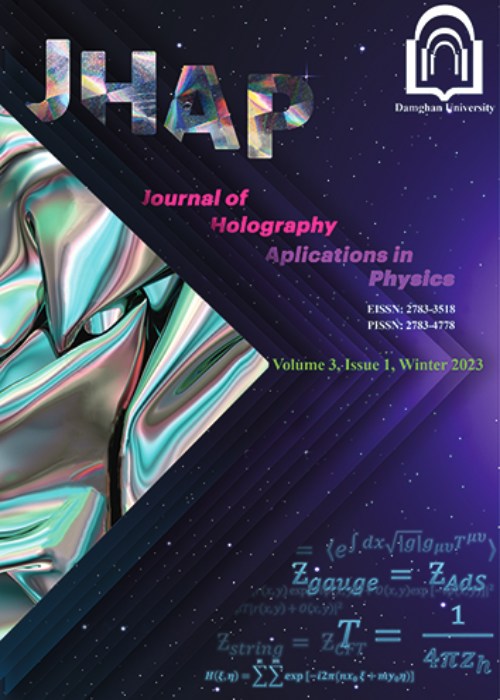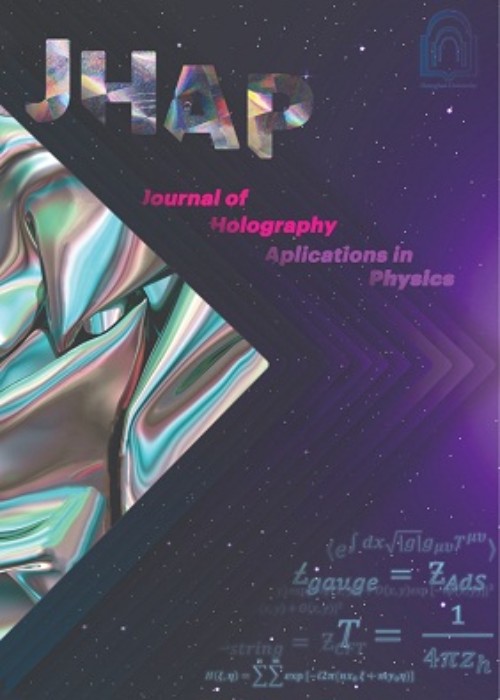فهرست مطالب

Journal of Holography Applications in Physics
Volume:3 Issue: 1, Winter 2023
- تاریخ انتشار: 1401/12/10
- تعداد عناوین: 6
-
-
Pages 1-30
This paper describes a phenomenon in which all but a tiny fraction of the fundamental holographic degrees of the SYK theory are confined (as in quark confinement) in the double-scaled infinite temperature limit. The mechanism for confinement is an essential ingredient in the duality between DSSYK and de Sitter space.The mechanism, which removes almost all states from the physical spectrum of the bulk de Sitter theory applies to configurations of a small number of fermions which would be expected to comprise Hawking radiation in de Sitter space. Without confinement there would be far too many species of Hawking particles. The mechanism also applies to configurations with larger number of fermions, including the objects described by chord diagrams.
Keywords: Holography, Quark Confinement, Hawking radiation -
Pages 31-38
In quantum mechanics without application of any superselection rule tothe set of the observables, a closed quantum system temporally evolves unitarily, andthis Lorentzian regime is characterized by von Neumann entropy of exactly zero.In the holographic theory in the classicalized ground state, we argue that the unitary real-time evolution of a non-relativistic free particle with complex-valued quantum probability amplitude in this Lorentzian regime can be temporally analytically continued toan imaginary-time classical stochastic process with real-valued conditional probabilitydensity in the Euclidean regime, where the von Neumann entropy of the classicalizedhologram and the information of a particle trajectory acquired by the classicalized hologram are positive valued.This argument could shed light on the Euclidean regime of the holographic Universe.
Keywords: Quantum Measurement, von Neumann Entropy, Holographic Principle, Wick Rotation -
Pages 39-48
We explain how quantum gravity, treated as an effective field theory, might modify theevaporative evolution of a four-dimensional, non-extremal, non-rotating, charged blackhole. With some approximations, we derive a set of coupled differential equations describingthe charge and mass of the black hole as a function of time. These equations representa generalisation of the analogous ones already present in the literature for classical blackholes.
Keywords: quantum black holes, black hole evolution, effective field theory -
Pages 49-56
In this paper, we consider a (2+1) D black hole conformally coupled to a masslessscalar. Then the geodesic motion of test particles and light rays in the vicinity of the spacetime ofthis black hole is studied. Moreover, the geodesic equations are solved analytically according toWeierstrass elliptic and derivatives of Kleinian sigma hyperelliptic functions. Also, the possibleorbits are discussed and classifi ed according to the particle's energy and angular momentum.
Keywords: black hole, Geodesic motion, Elliptic function, Analytical solution -
Pages 57-70
In this paper, we consider non-minimally coupled gravity model. We choose some suitable new variables and achieve the new Hamiltonian and Lagrangian which have harmonic oscillator form. The corresponding Lagrangian is deformed by non-commutative geometry. In order to have solution for the bouncing universe we specify the potential in the equation state. In that case we draw the equation of state in terms of time and show that the equation of state cross $-1$. Such bouncing behavior lead us to apply some conditions on $theta$ and $beta$ from non-commutative geometry. Here, also we can check the stability of system due to deformation of the non-minimally coupled to gravity model. In order to examine thestability of system we obtain the variation of pressure with respect to density energy. Also, we draw the variation of pressure with respect to energy density and show the condition of stability.
Keywords: Non-commutative geometry, Non-minimally coupled gravity, Bouncing universe, Dark Energy -
Pages 71-79
We apply the hard-wall model for the nucleon-Roper transition form factors investigation and consider the N+γ^*→R(1710) transition. The profile functions of the spinor and vector fields in the bulk of AdS space are presented. We plot the Dirac and Pauli form factor dependencies on transferred momentum square. Also, the spiral amplitudes for these transitions are presented. The hard-wall results are close to experimental data and nonrelativistic quark model at some point.
Keywords: AdS, CFT correspondence, Hard-wall model, Roper nucleon, Electromagnetic form factors, Pauli, Dirac formfactors, Helicity amplitude


